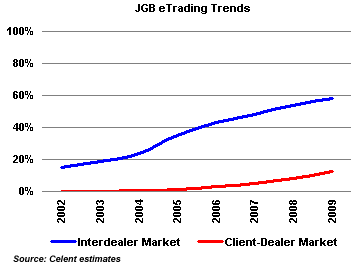eJGBs: e-Trading in The Japanese Government Bond Market
Abstract
E-trading of Japanese government bonds is finally gaining traction.
The Japanese government bond (JGB) market, with US$5.6 trillion of outstanding issues at the end of 2005, is the largest sovereign debt market in the world. But the e-bond revolution, which has taken other international markets by storm, has been slow in coming to Japan. The interdealer market is steadily embracing electronic trading and most trading in the client-dealer market is still done by voice with less than two percent of trading occurring on a handful of electronic multidealer platforms.
The future, however, may look entirely different, according to Celent's new report, . Over the past year, e-trading volumes in the multidealer market have grown, boosted by increased concerns to provide best execution and renewed volatility in the bond markets. E-trading in the interdealer market continues to rise steadily.
E-trading will rise from 35.2% of overall JGB trading in 2005 to 58% in 2009 in the interdealer cash market and will surge from only 1.1% in 2005 to 12.7% by 2009 in the client-dealer market, according to the report.

"With Japan's economy in recovery mode, and the expected abolition of Japan's zero percent monetary policy, the JGB market will see increased volatility and trading volumes which, in turn, should make the efficiencies of e-trading more attractive," says Neil Katkov, manager of Celent's Asia Research group and author of the report. "Issues remain, however; electronic trading of JGB repos is still nonexistent, and likely to remain so for some time."
The report provides an overview of the Japanese government bond market, analyzes electronic trading trends in the interdealer and client-dealer markets, and describes the drivers and barriers affecting the adoption of e-trading in JGBs. The report also profiles the interdealer and multidealer eJGB platforms currently in operation and concludes with a consideration of future trends for the electronic trading of Japanese government bonds.
The 30-page report contains 21 figures and 7 tables. A table of contents is available here.

